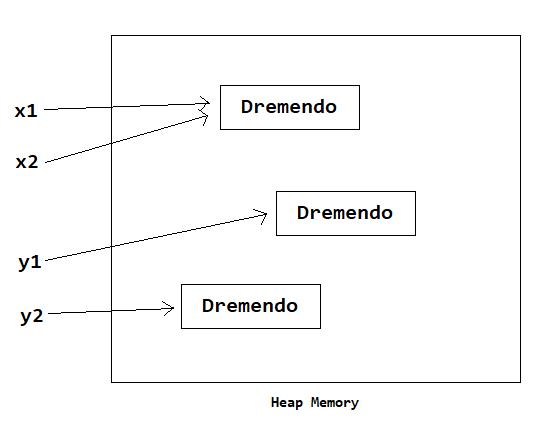String in Java Programming
String in Java
In this lesson, we will understand what is String in Java Programming along with some examples.
What is String in Java
A String is a class in java which is used to store a sequence of characters in the form of a character array. A String is immutable means that it can't be altered directly once it is created. To alter its value, we have to replace it with the newly created string.
A string in java can be created in three ways using.
- String Class
- StringBuffer Class
- StringBuilder Class
In this lesson we will discuss about the String Class and its various methods. StringBuffer and StringBuilder class will be discussed in the subsequent lessons.
String Literal and String Object
A String class be used in two ways to store a string, either by creating a Literal or by creating an Object.
Syntax of Creating a String Literal
String literal_name="string value";Example
String s1="Dremendo";Here we have declared a string literal s1 and initialize it with the string value Dremendo.
Syntax of Creating a String Object
String object_name=new String("string value");Example
String s2=new String("Dremendo");Here we have declared a string object s2 and initialize it with the string value Dremendo.
Difference Between String Literal and String Object
The difference between string literal and string object is that.
- When we create two string literals, having the same string in it. They will not create two separate space in the heap memory to store the same string. Both the literals will point to a common space in the heap memory where the string is stored.
- When we create two string object, having the same string in it. They will create two separate space in the heap memory to store the same string. Both the objects will point to a different space in the heap memory where the strings are stored.
Let's see the example given below.
Example
String x1="Dremendo", x2="Dremendo";
String y1=new String("Dremendo");
String y2=new String("Dremendo");
Note: A String Literals is also an object of String class, but it does not create separate space if the string value is already available in the heap memory. It points to space already created before by some other literal with the same string value, as shown in the above image.
Methods of String Class
String methods are useful functions used to perform a specific task on the string. Below we have discussed all the important string methods available in the String class.
length() Method
The length() method returns the total number of characters (including space) present in the string.
Example
import java.util.Scanner;
public class StringMethod
{
public static void main(String args[])
{
String s;
int l;
Scanner sc=new Scanner(System.in);
System.out.println("Enter a string");
s=sc.nextLine();
l=s.length();
System.out.println("Length="+l);
}
}Output
Enter a string Hello World Length=11
charAt() Method
The charAt() method returns the character at the specified index. In a string, the first character starts from index 0.
Example
import java.util.Scanner;
public class StringMethod
{
public static void main(String args[])
{
String s;
Scanner sc=new Scanner(System.in);
System.out.println("Enter a string");
s=sc.nextLine();
System.out.println("Character at index 3="+s.charAt(3));
}
}Output
Enter a string Dremendo Character at index 3=m
indexOf() Method
The indexOf() method returns the index of the first occurrence of the specified character or string within the current string. The indexOf() method accepts two arguments. The first argument is the string or character and the second optional argument is the index from where we want to check the occurrence. If the index is not given, it will start checking the occurrence from index 0.
Example
import java.util.Scanner;
public class StringMethod
{
public static void main(String args[])
{
String s1,s2;
Scanner sc=new Scanner(System.in);
System.out.println("Enter 2 strings");
s1=sc.nextLine();
s2=sc.nextLine();
System.out.println("The 2nd string first occur at index " + s1.indexOf(s2) + " in the first string.");
System.out.println("After index 5, the 2nd string first occur at index " + s1.indexOf(s2,5) + " in the first string.");
}
}Output
Enter 2 strings I am a boy and I love java programming. I The 2nd string first occur at index 0 in the first string. After index 5, the 2nd string first occur at index 15 in the first string.
lastIndexOf() Method
The lastIndexOf() method returns the index of the last occurrence of the specified character or string within the current string.
Example
import java.util.Scanner;
public class StringMethod
{
public static void main(String args[])
{
String s1,s2;
Scanner sc=new Scanner(System.in);
System.out.println("Enter 2 strings");
s1=sc.nextLine();
s2=sc.nextLine();
System.out.println("The 2nd string last occur at index " + s1.lastIndexOf(s2) + " in the first string.");
}
}Output
Enter 2 strings I am a boy and I love playing football. I The 2nd string last occur at index 15 in the first string.
compareTo() Method
The compareTo() method compares two strings lexicographically including case sensitive comparison. It returns a negative value if the first string is less then the second string. A positive value if the first string is greater than the second string. It returns zero if both are same.
Example
import java.util.Scanner;
public class StringMethod
{
public static void main(String args[])
{
String s1,s2;
Scanner sc=new Scanner(System.in);
System.out.println("Enter 2 strings");
s1=sc.nextLine();
s2=sc.nextLine();
if(s1.compareTo(s2)==0)
{
System.out.println("Both are same string");
}
else
{
System.out.println("They are not same");
}
}
}Output
Enter 2 strings Apple apple They are not same
compareToIgnoreCase() Method
The compareToIgnoreCase() method compares two strings lexicographically ignoring case sensitive comparison. It returns a negative value if the first string is less then the second string. A positive value if the first string is greater than the second string. It returns zero if both are same.
Example
import java.util.Scanner;
public class StringMethod
{
public static void main(String args[])
{
String s1,s2;
Scanner sc=new Scanner(System.in);
System.out.println("Enter 2 strings");
s1=sc.nextLine();
s2=sc.nextLine();
if(s1.compareToIgnoreCase(s2)==0)
{
System.out.println("Both are same string");
}
else
{
System.out.println("They are not same");
}
}
}Output
Enter 2 strings Apple ApPlE Both are same string
equals() Method
The equals() method compares two strings, including case sensitive comparison. It returns true if both the string contents are same otherwise it returns false.
Example
import java.util.Scanner;
public class StringMethod
{
public static void main(String args[])
{
String s1,s2;
Scanner sc=new Scanner(System.in);
System.out.println("Enter 2 strings");
s1=sc.nextLine();
s2=sc.nextLine();
if(s1.equals(s2)==true)
{
System.out.println("Both are same string");
}
else
{
System.out.println("They are not same");
}
}
}Output
Enter 2 strings Orange Orange Both are same string
equalsIgnoreCase() Method
The equalsIgnoreCase() method compares two strings, ignoring case sensitive comparison. It returns true if both the string contents are same otherwise it returns false.
Example
import java.util.Scanner;
public class StringMethod
{
public static void main(String args[])
{
String s1,s2;
Scanner sc=new Scanner(System.in);
System.out.println("Enter 2 strings");
s1=sc.nextLine();
s2=sc.nextLine();
if(s1.equalsIgnoreCase(s2)==true)
{
System.out.println("Both are same string");
}
else
{
System.out.println("They are not same");
}
}
}Output
Enter 2 strings BanaNA baNaNa Both are same string
startsWith() Method
The startsWith() method returns true if the first string starts with the specified second string, otherwise, it returns false. The startsWith() method accepts two arguments. The first argument is the string and the second optional argument is the index from where we want to check. If the index is not given, it will start checking from index 0.
Example
import java.util.Scanner;
public class StringMethod
{
public static void main(String args[])
{
String s1,s2;
Scanner sc=new Scanner(System.in);
System.out.println("Enter 2 strings");
s1=sc.nextLine();
s2=sc.nextLine();
if(s1.startsWith(s2)==true)
{
System.out.println("Yes, 1st string starts with the 2nd string from index 0.");
}
else
{
System.out.println("No, 1st string does not starts with the 2nd string from index 0");
}
// We are checking if the string s1 starts with the string s2 from index 15.
if(s1.startsWith(s2,15)==true)
{
System.out.println("Yes, 1st string starts with the 2nd string from index 15.");
}
else
{
System.out.println("No, 1st string does not starts with the 2nd string from index 15");
}
}
}Output
Enter 2 strings I am a boy and I love gaming. I Yes, 1st string starts with the 2nd string from index 0. Yes, 1st string starts with the 2nd string from index 15.
endsWith() Method
The endsWith() method returns true if the first string ends with the specified second string, otherwise, it returns false.
Example
import java.util.Scanner;
public class StringMethod
{
public static void main(String args[])
{
String s1,s2;
Scanner sc=new Scanner(System.in);
System.out.println("Enter 2 strings");
s1=sc.nextLine();
s2=sc.nextLine();
if(s1.endsWith(s2)==true)
{
System.out.println("Yes, 1st string ends with the 2nd string.");
}
else
{
System.out.println("No, 1st string does not ends with the 2nd string.");
}
}
}Output
Enter 2 strings I am learning Java Java Yes, 1st string ends with the 2nd string.
contains() Method
The contains() method returns true if the string contains the specified sequence of char values in it. Otherwise, it returns false.
Example
import java.util.Scanner;
public class StringMethod
{
public static void main(String args[])
{
String s1,s2;
Scanner sc=new Scanner(System.in);
System.out.println("Enter 2 strings");
s1=sc.nextLine();
s2=sc.nextLine();
if(s1.contains(s2)==true)
{
System.out.println("Yes, 1st string contains the 2nd string in it.");
}
else
{
System.out.println("No, 1st string does not contains the 2nd string in it.");
}
}
}Output
Enter 2 strings Hello how are you? are Yes, 1st string contains the 2nd string in it.
concat() Method
The concat() method concatenates the specified string to the end of the current string, but it does not originally update the current string. To update the current string we have to replace it with the concatenated string as shown in the example below.
Example
import java.util.Scanner;
public class StringMethod
{
public static void main(String args[])
{
String s1,s2;
Scanner sc=new Scanner(System.in);
System.out.println("Enter 2 strings");
s1=sc.nextLine();
s2=sc.nextLine();
// Concatenated string
System.out.println("Concatenated string");
System.out.println(s1.concat(s2));
// Original string
System.out.println("Original string");
System.out.println(s1);
// Update the original string with the concatenated string
s1=s1.concat(s2);
// Original string after replacing it with the concatenated string
System.out.println("Original string after replacing it with the concatenated string");
System.out.println(s1);
}
}Output
Enter 2 strings good bye Concatenated string goodbye Original string good Original string after replacing it with the concatenated string goodbye
replace() Method
The replace() method returns a new string after replacing all the occurrences of a specified character or string with the other specified character or string.
Example
import java.util.Scanner;
public class StringMethod
{
public static void main(String args[])
{
String s1;
Scanner sc=new Scanner(System.in);
System.out.println("Enter a string");
s1=sc.nextLine();
System.out.println(s1.replace('a','p'));
System.out.println(s1.replace("dog","cat"));
}
}Output
My dog name is max. My dog loves to eat meat every day. My dog npme is mpx. My dog loves to ept mept every dpy. My cat name is max. My cat loves to eat meat every day.
substring() Method
The substring() method returns a new string which is a substring of the current string.
Example
import java.util.Scanner;
public class StringMethod
{
public static void main(String args[])
{
String s1;
Scanner sc=new Scanner(System.in);
System.out.println("Enter a string");
s1=sc.nextLine();
System.out.println("Print the 1st 3 characters of the current string");
System.out.println(s1.substring(0,3));
System.out.println("Print the 1st 3 characters starting from index 2 and stopping at index 5");
System.out.println("The stopping index is not included in the substring");
System.out.println(s1.substring(2,5));
System.out.println("Print all the characters starting from index 3 till end");
System.out.println(s1.substring(3));
}
}Output
Enter a string Dremendo Print the 1st 3 characters of the current string Dre Print the 1st 3 characters starting from index 2 and stopping at index 5 The stopping index is not included in the substring eme Print all the characters starting from index 3 till end mendo
toLowerCase() Method
The toLowerCase() method returns a new string after converting all the characters of the string in lowercase.
Example
import java.util.Scanner;
public class StringMethod
{
public static void main(String args[])
{
String s1;
Scanner sc=new Scanner(System.in);
System.out.println("Enter a string");
s1=sc.nextLine();
System.out.println(s1.toLowerCase());
}
}Output
Enter a string Hello World hello world
toUpperCase() Method
The toUpperCase() method returns a new string after converting all the characters of the string in uppercase.
Example
import java.util.Scanner;
public class StringMethod
{
public static void main(String args[])
{
String s1;
Scanner sc=new Scanner(System.in);
System.out.println("Enter a string");
s1=sc.nextLine();
System.out.println(s1.toUpperCase());
}
}Output
Enter a string Hello World HELLO WORLD
trim() Method
The trim() method returns a new string after removing all the whitespaces from beginning and end of the string.
Example
import java.util.Scanner;
public class StringMethod
{
public static void main(String args[])
{
String s1;
Scanner sc=new Scanner(System.in);
System.out.println("Enter a string");
s1=sc.nextLine();
System.out.println(s1.trim());
}
}Output
Enter a string
Hello World
Hello World
toCharArray() Method
The toCharArray() method converts the string to a new character array for easy manipulation.
Example
import java.util.Scanner;
public class StringMethod
{
public static void main(String args[])
{
String s1;
char a[];
int i;
Scanner sc=new Scanner(System.in);
System.out.println("Enter a string");
s1=sc.nextLine();
a=s1.toCharArray();
// Printing the character array on the screen
for(i=0; i<a.length; i++)
{
System.out.println(a[i]);
}
}
}Output
Enter a string Computer C o m p u t e r
Note: You can convert a string into a character array if you want to apply a sorting algorithm on it to arrange the characters in either ascending or descending order.
Methods of Character Class
Character methods are useful functions used to perform a specific task on a character. Below we have discussed all the important character methods available in the Character class.
isAlphabetic() Method
The isAlphabetic() method returns true if the character is an alphabet. Otherwise, it returns false.
Example
import java.util.Scanner;
public class StringMethod
{
public static void main(String args[])
{
char c;
Scanner sc=new Scanner(System.in);
System.out.println("Enter a character");
c=sc.nextLine().charAt(0);
System.out.println(Character.isAlphabetic(c));
}
}Output
Enter a character a true
isDigit() Method
The isDigit() method returns true if the character is a digit. Otherwise, it returns false.
Example
import java.util.Scanner;
public class StringMethod
{
public static void main(String args[])
{
char c;
Scanner sc=new Scanner(System.in);
System.out.println("Enter a character");
c=sc.nextLine().charAt(0);
System.out.println(Character.isDigit(c));
}
}Output
Enter a character 8 true
isUpperCase() Method
The isUpperCase() method returns true if the character is an uppercase character. Otherwise, it returns false.
Example
import java.util.Scanner;
public class StringMethod
{
public static void main(String args[])
{
char c;
Scanner sc=new Scanner(System.in);
System.out.println("Enter a character");
c=sc.nextLine().charAt(0);
System.out.println(Character.isUpperCase(c));
}
}Output
Enter a character D true
isLowerCase() Method
The isLowerCase() method returns true if the character is a lowercase character. Otherwise, it returns false.
Example
import java.util.Scanner;
public class StringMethod
{
public static void main(String args[])
{
char c;
Scanner sc=new Scanner(System.in);
System.out.println("Enter a character");
c=sc.nextLine().charAt(0);
System.out.println(Character.isLowerCase(c));
}
}Output
Enter a character d true
toUpperCase() Method
The toUpperCase() method returns the uppercase version of the given character.
Example
import java.util.Scanner;
public class StringMethod
{
public static void main(String args[])
{
char c;
Scanner sc=new Scanner(System.in);
System.out.println("Enter a character");
c=sc.nextLine().charAt(0);
System.out.println(Character.toUpperCase(c));
}
}Output
Enter a character d D
toLowerCase() Method
The toLowerCase() method returns the lowercase version of the given character.
Example
import java.util.Scanner;
public class StringMethod
{
public static void main(String args[])
{
char c;
Scanner sc=new Scanner(System.in);
System.out.println("Enter a character");
c=sc.nextLine().charAt(0);
System.out.println(Character.toLowerCase(c));
}
}Output
Enter a character D d
Test Your Knowledge
Attempt the practical questions to check if the lesson is adequately clear to you.




